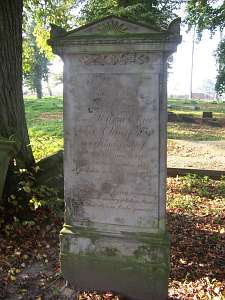|
gm. Gronowo Elbl±skie, pow. elbl±ski, woj. warmińsko - mazurskie
Until 1945 Fischau, TK (Gotha, Endersch Schrötter)

The village was mentioned in 1257 as a seat of a commandry. The village probably had a castle. In 1510, the village had 49.5 włókas of land. The church dates from the 2nd quarter of the 14th century. In 1643, the residents erected a Lutheran church, which was replaced by a new church in 1706, which in turn was replaced in 1886. The sources from 1776 mentioned the name Dirck Dick. In 1820, the village has 387 residents, including 7 Mennonites, who belonged to the community in Jezioro - Markusy. In 1860, the village had 34 houses and was inhabited by Catholics, Lutherans, and 8 Mennonites. Village layout - linear village situated along the Gronowo - Stare Pole road with perpendicular roads to D±growo and Rozgart; a cemetery with ruins of a catholic church located in the eastern section of the village, on the northern side of the road; an Lutheran cemetery situated in the village center at the road intersection. Until 1945, the village had 5 large farms - one located on in the northern section and 4 in the southern section. The cultural landscape has been destroyed. Both cemeteries have survived, but the Catholic church is in ruins. The Lutheran church was demolished after 1945. The homestead in the village center, on the northern side of the road has survived in fragments (farm buildings demolished). Other homesteads, including a Baroque manor house have been destroyed. The buildings (until 1945, quite numerous) around the Catholic cemetery are almost completely destroyed. In 1990s, the village still had several wooden buildings, but none of them have survived. The examples of historical architecture include several masonry buildings from the beginning of the 20th century. Rows of trees along the road and driveways, historical field layout, and draining canal system have survived.
 The Lutheran cemetery is situated in the southern side of the
intersection of the roads to Zwierzno, Jezioro, and Stare Pole. The
cemetery layout, remains of surrounding vegetation, main and crosswise
alleys, and a steel structure of a belfry have survived. The church was
demolished after 1945. Numerous gravestones are still present in the
cemetery. Present are the stalls with the names of Anna Siebert née
Penner, Maria Esau née Claassen, Agenta Jantzen, and Maria Pauls, among
others. The Lutheran cemetery is situated in the southern side of the
intersection of the roads to Zwierzno, Jezioro, and Stare Pole. The
cemetery layout, remains of surrounding vegetation, main and crosswise
alleys, and a steel structure of a belfry have survived. The church was
demolished after 1945. Numerous gravestones are still present in the
cemetery. Present are the stalls with the names of Anna Siebert née
Penner, Maria Esau née Claassen, Agenta Jantzen, and Maria Pauls, among
others.
SGKP, t.II, s. 392-393,Schmid, s 37 - 48, BF, Lipińska, t.III, poz.75.
|

 The Lutheran cemetery is situated in the southern side of the
intersection of the roads to Zwierzno, Jezioro, and Stare Pole. The
cemetery layout, remains of surrounding vegetation, main and crosswise
alleys, and a steel structure of a belfry have survived. The church was
demolished after 1945. Numerous gravestones are still present in the
cemetery. Present are the stalls with the names of Anna Siebert née
Penner, Maria Esau née Claassen, Agenta Jantzen, and Maria Pauls, among
others.
The Lutheran cemetery is situated in the southern side of the
intersection of the roads to Zwierzno, Jezioro, and Stare Pole. The
cemetery layout, remains of surrounding vegetation, main and crosswise
alleys, and a steel structure of a belfry have survived. The church was
demolished after 1945. Numerous gravestones are still present in the
cemetery. Present are the stalls with the names of Anna Siebert née
Penner, Maria Esau née Claassen, Agenta Jantzen, and Maria Pauls, among
others.